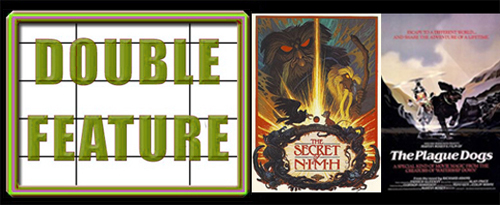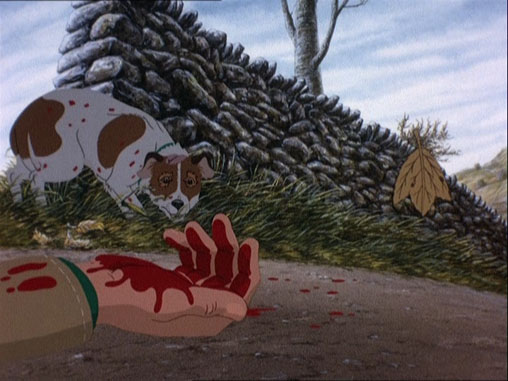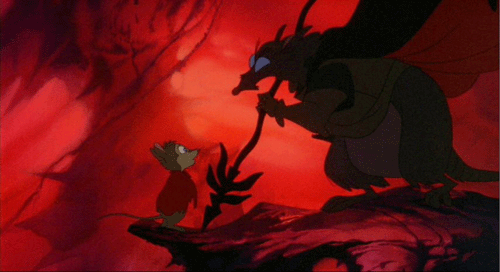
The double feature is cinema appreciation at its most basic. The mere act of pairing two films together – whether the bond be subject matter, central theme, a certain actor or filmmaker, or something outside-the-box conceptual – causes them to take on a different sort of life. A new relationship is formed with the viewer. You pay attention to new aspects and journey down unfamiliar avenues when you view films through Double Feature Goggles. Even when the linking bond is comically tenuous, the double feature magic is there. And I’m the kind of guy who derives just as much pleasure from creating a double feature as I do from watching one. Aside from amusing myself, hopefully I can give some people ideas for their next movie night.
The Double Feature: The Plague Dogs (1982) and The Secret of NIMH (1982)
The Connection: This is a sneaky sort of double feature; pairing two films that objectively seem almost boringly similar – both animated, both based on a book, both released in 1982, both dark, both from the perspective of animals, and both using experimental animal testing as a jumping off point for their narratives – but ultimately are extremely different in tone, plot, and execution.
Film 1: For an animated movie about talking animals, The Plague Dogs is a surprisingly bleak and messed up film, from beginning to end. Unsurprisingly, it is based on a book by Richard Adams, who is best remembered for a certain other bleak and messed up book about animals, Watership Down. It only makes sense that Martin Rosen, the same man who destroyed countless childhoods with his Watership adaptation in 1978, is responsible for this film too.
The story has a pretty gloomy and unpleasant set-up. We begin in an animal testing facility in Northern England, where vivisection and other experimentation for its own sake is being carried out on canines. Snitter (voiced with croaky despair by John Hurt), a small terrier, has undergone repeated brain surgeries and has a gnarly scar on the top of his head from where he’s been opened up. Rowf (Christopher Benjamin), a black lab, has been repeatedly thrown in a water tank and left to swim around until he drowns from exhaustion, only to be revived and tossed in again on a future day. Needless to say, when the dogs see a chance to escape, they do.
Where a Disney movie would now turn into a sort of road-picture adventure, Plague Dogs takes a more realistic and miserable approach. Snitter and Rowf are domesticated dogs. They don’t know much of anything about surviving in the wild, and hunger is a constant issue. They end up befriending a wily fox, who helps them find food, but the fox can do little help their problems with humans (amongst whom rumors are erroneously spreading that the dogs are carrying the bubonic plague). Meanwhile, the dogs are being hunted by the lab, all while growing thinner and mangier.
This is a straight up PG-13 cartoon, and many parents would probably not feel good about showing it to their kids. Some humans die, and the two starving dogs even eat the corpse of a pursuer at one point. But the film is extremely unique and very well done. It also features a provocative ending that is either dementedly sad or a happy relief depending on your glass half empty/half full status.

Film 2: The birth of The Secret of NIMH is one of the great fuck-you success stories of Hollywood. Don Bluth had been one of the chief animators at Disney during the 60’s and 70’s, but had grown increasingly frustrated and disillusioned with the quality of the Disney animated films, and the structure of the company afforded him no power to do anything about it. But he wasn’t the only frustrated one. Bluth left Disney in the late 70’s and took with him ten other animators to form Don Bluth Productions. After successfully creating a couple shorts, Bluth was looking for financial backing to make a feature. He found the perfect partner in Aurora Productions, a production company founded by some disenchanted former Disney executives. And the ultimate anti-Disney company was born!
It was surely this ballsy partnership that set them on the path to making The Secret of NIMH, a film that outwardly looks and moves like a Disney film, but is so much darker and weirder than anything the Mouse House would ever have allowed.
Adapted from Robert C. O’Brien’s children’s book, Mrs. Frisby and the Rats of NIMH, the films tells the story of Mrs. Brisby (Elizabeth Hartman), a timid field mouse caught in a horrible bind (the character’s name was changed so as not to be confused with the Frisbee toy). She needs to move her family before a farmer destroys her home, but her youngest son is too sick to be moved. So she seeks the wisdom of the Great Owl (John Carradine lending his ominously craggy pipes), who tells her to find the secret cabal of hyper-intelligent rats that live beneath the farm’s rose bush and speak with Nicodemus (Derek Jacobi). She does, finding a whole technologically advanced civilization of rats who steal electricity from the farmer. Here, from Nicodemus, she learns the truth behind all these hyper intelligent rodents. See, this isn’t just a standard animated animal tale with anthropomorphic rats and mice. These particular rodents came from a testing facility called NIMH (National Institute of Mental Health). Because of experiments done to the rodents, the rats and mice learned to read and eventually escaped. It was during the escape that Mrs. Brisby’s deceased husband played a crucial role, which now puts the widow in good standing with Nicodemus… but not with Jenner (Paul Shenar), a sinister rat who looks to overthrow Nicodemus.
Whereas Plague Dogs feels like a thoroughly sophisticated animated film, meant for adults, NIMH is almost more fucked up for kids because it seems so similar to classic Disney. Disney films certainly had their fair share of childhood scarring moments – the ugly witch from Snow White, the dragon in Sleeping Beauty, the entirety of the “Night on Bald Mountain” segment in Fantasia – but NIMH is just dripping with creepiness and terrifying (for kids) sequences. As a kid I nearly shit myself with dread when Mrs. Brisby visits the Great Owl, (goddamn Carradine and that haunting, resonating voice of his). Bluth really went bonkers with backlit animation techniques, which he used to make the amulet Nicodemus gives Mrs. Brisby glow, but also to make all the eyeballs of the creepier character glow ominously too. That fucked my shit up when I was a kid. There’s just something about the rhythm of this film that feels dark and off-putting. And don’t even get me started on the goddamn scene where Mrs. Brisby has to drug the farmer’s demonic looking cat, Dragon. Seeing that as a wee lad I don’t think I was ever so tense during a film scene until seeing the infamous Alfred Molina/Thomas Jane/fireworks-throwing-Asian-toyboy scene in Boogie Nights. I’m going to have night terrors now, just thinking about these old memories.
Alas, the ballsy confidence that created NIMH soon gave way to leveler thinking when the film underperformed at the box office, and Bluth immediately dived into sillier non-emotionally-scarring films like An American Tale, Land Before Time, and All Dogs Go To Heaven, before his company’s novelty was blown out of the water by Disney’s late-80’s history making renaissance.

Double Feature Goggles: Those who respect animation can get a lot out of looking at the chasm of difference between Rosen and Bluth’s style. Dogs, like Watership Down, has very stripped down style that serves to accentuate the bleak nature of the film. It is a utilitarian style, as though the filmmaker were using animation purely because it was the only means possible to accurately tell the story of two dogs and a fox. Though the film used zero rotoscoping (the tracing of live-action footage), the film has a very natural, real feel to it. There is nothing impressionistic or expressionistic in the character design, character animation, or backdrops.
Bluth on the other hand was schooled in the Disney style, and stylistically moved back to the classic age of Disney, before the studio started using the graphic reproduction process – where a Xerox machine was uses to transfer the artists’ sketches directly to the cells (which had previously been transferred by hand, by an inking department). 101 Dalmations was the first Disney film to use the process, which gave the Disney films of the 60’s and 70’s their signature sketchy look. The upside of the graphic reproduction was a speedier process, plus a preservation of some of the spontaneity found in the pencil sketches. But it also deprived the animation of some of its class (Walt apparently hated it, but couldn’t argue with all the money he was saving by cutting the inking stage). NIMH was Bluth’s chance to return animation to its glory days, he felt, and the painstaking work he and his team put in shows. The color palette of NIMH is ridiculous, the likes of which had not been seen in an animated film in decades – as Disney had moved towards a fairly bland coloring scheme.
It’s also interesting to see how both films portray the animal testing labs. Both take a decidedly negative approach, but in their respective styles. Plague Dogs is bleak misery, with the lab scenes having a similar kind of wanton, pointless cruelty as a concentration camp, and the film can easily be taken as a piece of anti-animal testing propaganda. NIMH uses the animal testing as more of a horror story. Seen only in flashbacks, the lab is scary, but it is also the genesis story for all our hyper-intelligent characters. So in a sense, it is anti-animal testing in the same way the Incredible Hulk was anti-gamma radiation testing.
Viewing Order: I don’t think viewing order is crucial here, though Plague Dogs is slower and more serious than NIMH, so by standard Double Feature wisdom it is probably best to do Dogs first.